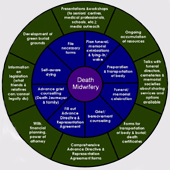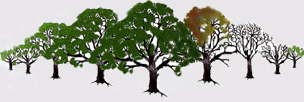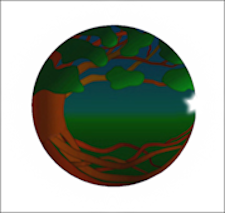|
Clarification
of new terms: After winning the
right to continue to use the term 'death
midwife' in the lower Supreme Court (CMBC
vs MaryMoon),
it was lost in the appeal (CMBC/AGBC
vs MaryMoon).
Although
we are continuing to explore ways to reclaim
the term 'death midwife', we are legally
bound (in BC) to use new terms for the time
being. The terms we are currently
using are:
Practitioner
of death midwifery:
someone who is practicing the philosophy
of midwifery applied to deathcare, through
the pan-death continuum.
Pan-death
guide: someone who offers death midwifery
support in a continuum of pre-death (EOL/death
doula role), immediately after death (home
funeral guide role), and funeral/memorial
ceremonies (celebrant role).
For
the most part on this site, 'practitioner
of death midwifery' and 'pan-death guide'
will be used interchangeably. We
realize that this may be a little confusing.
However, we felt it was important
to retain the connection to 'death midwifery'
(philosophy), as well as have a term that
describes 'what they do' —
as 'death midwife' did both.
|
|

Summary
of CINDEA's
definition of Death Midwifery
In
the simplest sense, a modern-day practitioner
of death midwifery/pan-death guide is
a facilitator who offers a continuum of
direct and integrated guidance and support
to the Death Journeyer and their family
throughout a personalized and participatory
pan-death process.
'Community
deathcare' is a broader term than 'death
midwifery', though the first includes
second. Community deathcare
supports all pracitioners who contribute
to deathcare in some form, but more specifically
to those which are alternatives to conventional
care. In a sense, it is a synonym
for what CINDEA refers to as DWENA
options.
The CINDEA definition seeks to
honour and parallel the ancient double
(birth/death) role
of midwives, while acknowledging that
practitioners of death midwifery are NOT
required to have the medical side of a
birth midwife's responsibilities. [see
Parallels
between Birth and Death Midwifery
below]
Disclaimer:
Practitioners of death midwifery/pan-death
guides are not conventional (birth) midwives
or health professionals, nor are they
members of any of the Colleges of Midwives
in Canada.
|

Description
of Death Midwifery
CINDEA
recognition of 'practitioners of death midwifery'/'pan-death
guides' includes the following primary roles:
| |
 |
provide
information on various options throughout
the pan-death process (especially
those which are alternatives to the cultural
norms or less institutionalized) including
advance planning issues, necessary
documents (death certificates,
permits, etc. and filing them), and
other support resources in the community |
| |

|
support
the exploration of DWENA options that are
most meaningful to the death journeyer/family,
and how to fulfill them |
| |
 |
educate
and guide the family through whatever family-based/at-home
options they choose (home funeral);
as well as support them in those that may
include the use of a funeral home for specific
individual services if needed, such as transporting
the body (according to their
choice) |
 |
support
the family in accessing their legal rights
in situations where the death journeyer
is not able to die at home, or other complicated
situations — ex. bringing the body
home from hospital after death, etc.
|
| |

|
provide
in-person emotional and spiritual support,
or facilitate access to specialists who can
do so |
 |
collaborate
with the family to develop whatever ceremonies
they wish —
including, but not limited to, funeral/memorial
ceremonies |
| |

|
generally
support, and advocate for, the wishes of the
Death Journeyer and their family throughout
all of the pan-death stages [see
7
Stages on the Pan-Death Movement page] |
(return
to top)

Expectations
of Death Midwifery Practitioners
CINDEA
expects practitioners of death midwifery to:
| |
 |
to
be knowledgeable about both regular and DWENA
services in their local community; and provide
information about, and access to, those services
as appropriate; |
| |

|
work
with the Death Journeyer and their family
— as 'gatekeeper' — to arrange the
best way to provide visitation access for
family members and friends; while at the same
time protecting the Death Journeyer's privacy,
need for rest, etc.; |
| |

|
journey
with (or witness for)
the Death Journeyer and their family throughout
the whole pan-death process; and
provide a continuum of integrated service
(to the degree that they wish) —
which may be unavailable within the current
split between pre- and post-death services; |
| |

|
as
well as integrate all of the values listed
under Values
of the Modern Pan-Death Movement |
(return
to top)

Web
of Facets of
Practitioners of Death Midwifery/Pan-Death Guides
 |
Please
click on the thumbnail to the left for a full-size
view of the web of facets.
The
inner blue ring in the web indicates the
facets of care that a pan-death guide will
support the family to do, and which are
their primary responsibility. The
outer green circle represents the additional
elements of developing DWENA pan-death care
that CINDEA encourages recognized
practitioners of death midwifery to participate
in — although some practitioners may
focus more on certain facets than others. The
outer green circle represents the additional
elements of developing DWENA pan-death care
that CINDEA encourages recognized
practitioners of death midwifery to participate
in — although some practitioners may
focus more on certain facets than others.
For
more specifics on the full range of pan-death
care, please see our pages on Advance
Care Planning and Post-death
care/Home Funerals.
|
(return
to top)

Advantages
of a Pan-Death Process
While
other DWENA practitioners (see
list on the Modern
Pan-Death Movement page) may or may
not offer all the services in the Web of Facets
above, a pan-death guide (by
definition) is required to provide all
of the inner green circle — either directly,
or by having enough knowledge to both supply general
information and recommend any specialists that
might be required (supportive Funeral
Homes for individual services, grief counsellors,
etc). The
primary advantage of using a pan-death guide —
besides offering a comprehensive range of direct
services — is the continuum provided to the
death journeyer and family throughout the whole
of the pan-death process. The
primary advantage of using a pan-death guide —
besides offering a comprehensive range of direct
services — is the continuum provided to the
death journeyer and family throughout the whole
of the pan-death process.
Cultural
disconnection of supports and services
The modern pan-death process
is becoming exponentially more complex. A
broader range of
medical intervention and support services is available;
families are living at greater distances from
each other and have often chosen very different
lifestyles and traditions (even
being estranged); etc. [see
more under
Development of the Modern Pan-Death Movement.] A
broader range of
medical intervention and support services is available;
families are living at greater distances from
each other and have often chosen very different
lifestyles and traditions (even
being estranged); etc. [see
more under
Development of the Modern Pan-Death Movement.]
| Most
people no longer live in communities/neighbourhoods:
instead |
| |
 |
there
is a loss of common cultural and religious
traditions; |
| |
 |
often
no or very few family members live close by; |
| |
 |
neighbours
may not have known each other at all (rarely
for decades as in the past); |
| |
 |
it can no longer be assumed what choices will
be made, and what support is needed (and
given, often without even being asked), by
the death journeyer and family. |
General
(MDs) or nurse practitioners
usually handle the overall direction of the Death
Journeyer's medical care, but often have too many
clients to be able to offer more than their medical
expertise. The
advent of hospice societies and palliative care
teams has made a very significant difference to
a Death Journeyer's ability to stay at home (and
most people, though not all, would prefer to),
and to their carer' ability to make that
possible. It is not yet viable for
these teams to provide the same range/kinds of
care (particularly the non-medical
ones) in all local areas of the country.
Furthermore,
they are likely to have limitations on the amount
of time that they can spend with the Death Journeyer
and family. As
a result, there may not be anyone — except
perhaps a solitary carer The
advent of hospice societies and palliative care
teams has made a very significant difference to
a Death Journeyer's ability to stay at home (and
most people, though not all, would prefer to),
and to their carer' ability to make that
possible. It is not yet viable for
these teams to provide the same range/kinds of
care (particularly the non-medical
ones) in all local areas of the country.
Furthermore,
they are likely to have limitations on the amount
of time that they can spend with the Death Journeyer
and family. As
a result, there may not be anyone — except
perhaps a solitary carer  who fully understands the whole situation surrounding
the Death Journeyer's dying/death.
who fully understands the whole situation surrounding
the Death Journeyer's dying/death.
| Continuum
provided by a Pan-death Guide Especially
if the practitioner is hired soon after a
terminal diagnosis or has been consulted in
EOL advance planning, they will be aware of: |
| |
 |
what
issues arise for the Death Journeyer as they
contemplate their imminent death — which
can be substantially different depending on
their specific situation (such
as their particular practical, economic/professional,
spiritual, emotional, or personal values,
ethnic/cultural traditions, etc.); |
| |
 |
the
choices/wishes of the Death Journeyer and/or
their families for the ongoing pan-death process,
and the personal values that those are based
on; |
| |
 |
the
family dynamics, what issues or concerns are
arising as the result of this imminent death
and how they are being handled, and what influence
that has on the Death Journeyer and/or their
primary carers; |
| |
 |
the
nature of the ethnic or cultural environment,
faith or professional community, etc. of the
Death Journeyer; and how it may influence
their choices or provide extra support; and |
| |
 |
the
particular services provided by hospice/palliative
care. |
This
awareness of the Death Journeyer's situation means
that the pan-death guide can support the family
throughout the pan-death process, without the
family having to repeatedly explain what
their wishes/choices are and why to various
providers (for example, separate
providers for palliative care and post-death care).
| This
continuum may be especially significant, if
|
| |
 |
the Death Journeyer's situation is complicated; |
| |
 |
there are only a few family members and friends
available to help; and/or |
| |
 |
the Death Journeyer chooses a 'self-aware
death' (also called 'conscious
dying' —
ongoing self-exploration in the context of
imminent death, and preparation for it),
which might lead to significant changes in
their original end-of-life choices. |
In
short, the practitioner of death midwifery can
be someone who is always available as a helping
hand, a listening ear, and a clear mind that keeps
track of all the individual details needed to
make the pan-death process as ideal as possible
for the Death Journeyer and all the people close
to them.
(return
to top)

Training
Options (Canadian and/or online)
for Alternative Death-care
Since
DWENA deathcare roles are still very new and evolving
in Canada, it can be difficult to find appropriate
training. However, an exponentially-growing
variety of individual courses or programs are
available. Some of them are
more academic (University or College
based, in Thanatology and related topics);
and useful for expanding one's awareness of the
issues involved, traditions from various religions
or ethnic groups across the globe, etc. Others
are more focused on the direct/hands-on involvement
with the Death Journeyer and their family —
whether centred on pre-death or post-death support,
or both.
CINDEA
has a list — Training
Options for Alternative Death-care May 2014
— which includes 35 options, most of which
are Canadian and/or online. However,
we note that this list is now out-of-date and
many more options are available (especially
in Death/End-of-Life Doula training). So
please
feel free to contact
us for support in figuring out what programs
or combination of courses might work best for
you, in terms of the particular service you wish
to offer.
(return
to top)

Philosophy
in/and Practice
Information on
(birth) midwives taken from Wikipedia
CINDEA
understands that a pan-death guide's role
cannot exactly parallel that of a birth midwife. We
are also well aware that there are long-term ramifications
to how a person enters our world
(birth) that are very different from the
considerations of those leaving it (death)
—
in particular that a birth midwife is responsible
for sustaining two lives, mother and child. We
are also well aware that there are long-term ramifications
to how a person enters our world
(birth) that are very different from the
considerations of those leaving it (death)
—
in particular that a birth midwife is responsible
for sustaining two lives, mother and child.
Canadian birth midwives are required to have considerable
medical training and certification, and be registered
with a provincial college. A pan-death
guide does not require medical training, since
they are not responsible for sustaining the life
of any individual.
Thus, such practitioners are not health professionals,
nor are they registered with any of the Colleges
of Midwives in Canada.
On the other hand, they are required
to have skills that a birth midwife does not need
—
especially in the
development and performance of ceremony.
Despite
the differences between the two practices (birth
and death midwifery), they share a comparable
philosophy. One description of the
philosophy of birth midwives can be found at "Philosophy
of Midwifery Care in Ontario". If
one replaces the birth-specific words in that
description by death-related words, that statement
would then describe the philosophy of death midwifery.
It
is CINDEA's intention to honour both the
ancient and conventional philosophy/approach of
the double birth/death role within midwifery,
as well as the vital and pan-birth role
of the birth midwife. Therefore,
we only use the terms 'practitioner of death midwifery'
or 'pan-death guide' to refer to those who are
committed to offering services throughout the
pan-death process. A
critical aspect of both philosophies is continuity
of care, whether pan-birth or pan-death.
Below is a list of aspects of death midwifery
practice, outlining that continuity. [Note:
in terms of a life-passage event, 'birth' —
not 'life' — is the opposite of 'death'.]
|
Elements
of Pan-Death Practice
(from
terminal diagnosis through active dying,
death, and post-death care)
|
|
| Educates
the public about the range of options for
death care |
|
| Assists
with advance care planning — Advance
Directives/Expressed Wishes and other related
documents |
|
| Primarily
deals with situations where the dying person
does not need to be hospitalized and is not
comatose or in severe dementia (though
can assist
family in such cases) |
|
| Primarily
deals with at-home or hospice deaths, where
family and friends want to participate directly
throughout the pan-death process.
Generally supports and encourages
a natural/at-home/hands-on pan-death process,
wherever practical |
|
| May
act as the Death Journeyer's and/or family's
advocate — with doctors, palliative care
team, cemeterians, etc. — to ensure that
they retain choice and control over the death
experience |
|
| Focuses
on supporting the family's direct participation,
as much as possible throughout (i.e.
family and friends mostly do it themselves)
— but is prepared to act directly when
needed |
|
| Works
in partnership with the Death Journeyer (and
family, palliative care team, etc.) |
|
| Suggests
specialists if the practitioner/guide can't
offer appropriate support in the circumstances
(palliative-care team/doctor,
funeral home, or grief counsellor for anticipatory
or post-death grief issues)
|
|
| Offers
support to both Death Journeyer and family
— especially guiding the immediate post-deathcare
and legal requirements — and continues
support immediately afterwards |
|
| May
be involved in grief or emotional support |
|
| Mainly
assists in the pan-death process, although
may also help with other issues around the
death as needed |
|
| Offers
an empathic disposition and active listening
skills to understand and support values and
choices |
|
| Provides
necessary equipment and/or informs the family
of what they need to prepare (stretcher
to move the body, Techni-Ice/Cryopak blankets,
copies
of certificates and/or permits,
etc.) |
|
Assists
with
developing and/or performing various kinds
of ceremonies that may be desired before,
during, and after the death — including
celebrations of life, wakes, funeral and/or
memorial services, as well as any rituals
that may spontaneously arise
|
(return
to top)
Parallels
between Birth and Death Midwifery
Information on
birth midwives taken from Wikipedia
Canadian
birth midwives are required to have considerable
medical training and certification.
A pracitioner of death midwifery does not require
medical training, because they are not responsible
for sustaining the life of any individual. On
the other hand, they are required to have skills
that a birth midwife usually doesn't —
especially with
the development and performance of pre/post-death
ceremony.
However,
CINDEA believes that the rest of the major
aspects of a birth midwife's role are generally
paralleled by that of pracitioners of death midwifery. We
hope that, by only using our designated 'pan-death'
terms in relation to those who are committed to
offering services throughout the pan-death process,
we will continue to honour both of the traditional
and culturally-held meanings of the term 'midwife'
—
as well as the vital and pan-birth role of the
birth midwife. We
hope that, by only using our designated 'pan-death'
terms in relation to those who are committed to
offering services throughout the pan-death process,
we will continue to honour both of the traditional
and culturally-held meanings of the term 'midwife'
—
as well as the vital and pan-birth role of the
birth midwife.
|
Birth
Midwifery
|
|
Death
Midwifery
|
| Pan-birth
care (pregnancy, labour, birth
and postpartum with nursing/etc.)
|
Pan-death
care (from terminal diagnosis
through active dying, death, and post-death
care) |
|
| Family
planning — advice on conception or contraception,
as well as nutrition counselling and advice
on home or hospital births |
|
Advance
Care Planning — Advance Directives/Expressed
Wishes and other related ACP documents
(though
usually not the post-death financial documents,
i.e wills) |
|
| Primarily
deals with low-risk pregnancy, where a hospital
birth may not be needed (though
can assist the mother with hospital or emergency
births as well) |
|
Primarily
deals with situations where the dying person
may not need to be hospitalized, and is not
comatose or in severe dementia (though
can assist
family in such cases) |
|
| Primarily
deals with natural and/or at-home births,
where family and friends may want to participate
directly throughout the pan-birth process |
|
Primarily
deals with at-home deaths, where family and
friends want to participate directly throughout
the pan-death process |
|
| Acts
as the mother's advocate — with doctors,
nurses, nutritionists, etc. — to ensure
that she retains choice and control over her
childbirth experience |
|
Acts
as the Death Journeyer's and/or family's advocate
— with doctors, palliative care team,
cemeterians, etc. — to ensure that they
retain choice and control over the death experience |
|
| Focuses
on supporting the family's direct participation,
as much as possible throughout — but
prepared to assist when needed (mother
and partner mostly do it themselves)
|
|
Focuses
on supporting the family's direct participation,
as much as possible throughout — but
prepared to assist when needed (family
and friends mostly do it themselves)
|
|
| Works
in partnership with the mother (and
partner, birth coach/doula, etc.) |
|
Works
in partnership with the Death Journeyer (and
family, palliative care team, etc.) |
|
| Refers
to other specialists if the birth midwife
can't offer appropriate support in the circumstances
(obstetrician or gynecologist,
GP, psychiatrist for postpartum depression,
etc.) |
|
Refers
to other specialists if the practitioner/guide
can't offer appropriate support in the circumstances
(palliative-care team/doctor,
funeral home, or grief counsellor for anticipatory
or post-death grief issues, etc.)
|
|
| Offers
care for both mother and child — especially
the immediate after-birth care of the child
— and including mother and child for
a month or more after the birth |
|
Offers
cares for both Death Journeyer and family
— especially guiding the immediate after-death
care by the family — and including the
family for some time afterwards |
|
| Usually
involved in educating the public in the range
of options for birth care |
|
Usually
involved in educating the public about the
range of options for death care |
|
| Mainly
assists in the pan-birth process, although
they may also help with other medical problems
relating to women when needed |
|
Mainly
assists in the pan-death process, although
they may also help with other issues around
death as needed |
|
| Offers
empathic disposition and active listening
skills to understand and support values and
choices |
|
Offers
empathic disposition and active listening
skills to understand and support values and
choices |
|
| Provides
necessary equipment and/or informs the family
of what they need to prepare (birthing
chair, stethoscope, other supplies needed
for the birth, birth certificate, etc.)
|
|
Provides
necessary equipment and/or informs the family
of what they need to prepare (stretcher
to move the body, Techni-Ice or Cryopak blankets,
copies
of certificates and/or permits,
etc.) |
|
| Birth
midwives generally support and encourage natural/at-home/hands-on
childbirth in all practical settings |
|
Pan-death
guides generally support and encourage a natural/at-home/hands-on
pan-death process in all practical settings
|
|
Licensed
birth midwives undergo an extensive period
of medical training, at least equal to the
qualifications of an RN
|
|
Practitioners
of death midwifery require skills and experience
in developing and performing various kinds
of ceremonies |
(return
to top)
|









